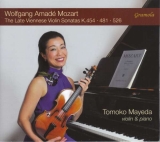In der Seglersprache nennt man jemanden, der alleine sein Boot steuert, wie etwa bei der Vendée Globe, dem vielleicht berühmtesten, mit Sicherheit aber härtesten Streckenrennen der Welt, einen Einhandsegler. Als Einhandspielerin kann man hier vielleicht Tomoko Mayeda bezeichnen.
Mit drei der späten Sonaten für Klavier und Violine von Mozart macht die Musikerin Tomoko Yameda auf sich aufmerksam. Dazu trägt als Besonderheit bei, dass sie, erstmalig seit Arthur Grumiaux vor 60 Jahren, den Klavier- und den Violinpart dieser Sonaten im Dialog mit sich selbst eingespielt hat. Dazu hat sie die Werke mit gut einem Quartal zeitlichem Abstand zunächst auf dem Tasteninstrument, dann der Violine aufgenommen.
Man mag sich fragen, was der Sinn dieser Herangehensweise ist. Sicherlich kann die Künstlerin zeigen, dass sie beide Instrumente sicher beherrscht und ausdrucksstark spielen kann. Aber lebt die Duosituation nicht gerade vom Dialog zweier Partner, die zueinander finden müssen. Dabei können dann aufregende Momente großer Gefahr, aber auch solche exorbitanter Köstlichkeit entstehen. In dieser Konstellation aber wirkt das Spiel elegant und fein abgestimmt, aber auch ohne Risiko und insofern fehlt ihm auch eine Komponente des Reizes. Denn Mayeda musste mit dem Geigenpart dem folgen, was sie Monate zuvor am Klavier eingespielt hatte. Dahinter konnte sie weder zurück noch darüber weiter hinaus.
Dabei herausgekommen ist eine ganz klassisch ausgerichtete, durchsichtig und abgesichert wirkende Interpretation, die im ersten Höreindruck mit ihrer Struktur und Ausgestaltung der Linien ausnehmend gefällt. Aber dann fehlt auf Dauer das Quäntchen Spontaneität, weil der zweite Teil zum ersten passen musste und somit die Interpretation auf dem früheren Zeitpunkt festgezurrt wurde.
In sailing parlance, someone who steers his boat alone, such as in the Vendée Globe, perhaps the most famous but certainly the toughest distance race in the world, is called a single-handed sailor. Tomoko Mayeda can perhaps be described as single-handed player here.
With three of the late sonatas for piano and violin by Mozart, the musician Tomoko Yameda attracts attention. A special feature is that, for the first time since Arthur Grumiaux 60 years ago, she has recorded both the piano and violin parts. To this end, she recorded the works a good quarter of the way apart, first on the keyboard and then on the violin.
One may wonder what the point of this approach is. Certainly the artist can show that she has a secure command of both instruments and can play expressively. But doesn’t the duo situation live from the dialogue of two partners who have to find each other. Exciting moments of great danger, but also those of exorbitant delicacy can then arise. In this constellation, however, the play seems elegant and finely tuned, but also without risk, and in this respect it also lacks a component of charm. For Mayeda had to follow with the violin part what she had recorded on the piano months before. She could neither go back nor beyond that.
The result is a very classically oriented, transparent and secure interpretation, which is exceptionally pleasing with its structure and shaping of the lines. But then in the long run the little bit of spontaneity is missing, because the second part had to fit to the first and thus the interpretation was fixed in the first recording already.
























